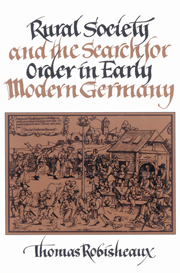Book contents
- Frontmatter
- Contents
- List of illustrations and tables
- Acknowledgments
- A note on usages
- Glossary
- List of abbreviations
- Introduction
- Part One Agrarian expansion, revolt, and the decay of community
- Part Two Search for order
- 4 Reformation, patriarchy, and marital discipline
- 5 Defending the patrimony
- 6 The unchristian economy
- 7 Threat of revolt
- Part Three Crisis and recovery
- Appendix A Distribution of wealth in Langenburg district, 1528–1581
- Appendix B Grain production and the peasant household
- Manuscript sources
- Bibliographical essay
- Index
4 - Reformation, patriarchy, and marital discipline
Published online by Cambridge University Press: 05 May 2010
- Frontmatter
- Contents
- List of illustrations and tables
- Acknowledgments
- A note on usages
- Glossary
- List of abbreviations
- Introduction
- Part One Agrarian expansion, revolt, and the decay of community
- Part Two Search for order
- 4 Reformation, patriarchy, and marital discipline
- 5 Defending the patrimony
- 6 The unchristian economy
- 7 Threat of revolt
- Part Three Crisis and recovery
- Appendix A Distribution of wealth in Langenburg district, 1528–1581
- Appendix B Grain production and the peasant household
- Manuscript sources
- Bibliographical essay
- Index
Summary
It is not easy to scan the broad spectrum of popular and learned responses to social conditions in Reformation Germany in the middle of the sixteenth century. Yet, if the pamphlet literature from this period can serve as a guide, one theme often stood out above all others: the fear of social, political, and religious disorder, the perception that the underpinnings of the whole social order were dangerously unstable, uncertain, continually in flux. That many pamphleteers still held up for their readers the social values of a society of orders – hierarchy, social harmony, religious unity, corporate solidarity, the common good, deference, obedience – could only have intensified the feeling for many that society had become unstable. For those ideals bore even less resemblance to social reality in 1550 than they had fifty years before. Out in the countryside, in a rural society like Hohenlohe, specific events and social conditions – the Peasants' War, the fear of rural unrest, the continued decay of the church, the uncertain power of the counts in the empire, the spread of poverty and population growth, the erosion of communal solidarity – lay behind the views voiced by contemporary observers of society. Protestant reformers called to Öhringen in the 1540s and 1550s, for example, were all deeply distressed by the social disorder and decay they saw around them.
- Type
- Chapter
- Information
- Publisher: Cambridge University PressPrint publication year: 1989
- 1
- Cited by



